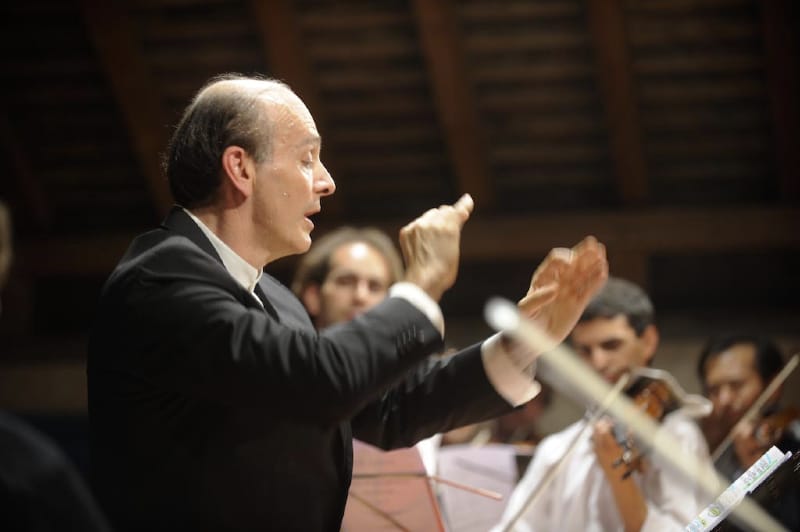
Grand Concert pour les Aixois: Haydn, Tchaikovsky , Mozart The Strings of Verbier Festival Chamber Orchestra / Gábor Takács-Nagy. Cathédale Saint-Saveur, Aix en Provence, France, 20.04.2025
Haydn Die sieben letzten Worte underes Erlöser am Kreutz, Hob. XX:1 (1786): Introduction
Tchaikovsky Serenade for Srings, Op. 48 (1880)
Mozart Divertimento in B flat, K 137 / K 125b (1772)
Performed to a completely packed cathedral in Aix (the Cathédrale Saint-Saveur), this was a carefully programmed afternoon of great beauty and power. The principal power came from the opening Haydn, the first movement (Maestoso ed adagio) of what in English is known as The Seven Last Words of Christ on the Cross. This piece exists in a number of versions (string quartet, choral, keyboard), but the orchestral version is the original. The piece was commissioned in 1786 for a Good Friday service at the Holy Cave Oratory in Cádiz, Spain.
The opening gesture, angular, emerged here as a real cri de cœur. The reverberation of the cathedral cared the music through silences as if to the skies and beyond; sitting up close, the effect was electrifying. The Verbier strings play standing (those that can), which seems to also add to the body of sound and their presence. Gábor Takács-Nagy (possibly best known for his work with Jean-Efflam Bavouzet and the Manchester Camerata in Mozart on Chandos), has not only a true grasp of Haydn’s often gestural processes, but obviously a close rapport with his players . And, if his facial expressions are anything to go by, he takes a real joy in the very act of music-making.
To give you the opportunity to hear the string orchestra version of the Introduction (and also performed in a church), here’s a performance by the Kyiv Chamber orchestra and Vadim Borysov:
Tchaikovsky’s Serenade for Strings is universally well-known of course, its popularity absolutely justified. Takács-Nagy and his Verbier players performed it with a freshness that enabled us, the audience, to hear it as if anew. There was a lovely parallel, too, between the Haydn’s opening Urschrei and the opening gesture of the initial ‘Pezzo in forma di sonatina,’ Tchaikovsky offering a stream of heartfelt angst. Tákacs-Nagy paced it perfectly, and had the Verbier strings phrase perfectly, too, with just the right shaping. He enabled contrast as the movement progressed, and yet everything was tightly controlled.
I know this is a Cathedral, but I felt sin come upon me: after the first movement, a significant part of the audience applauded; Takács-Nagy turned and reminded them that there were still three movements to go: at which point I felt like applauding him. As for what he said, Amen to that, as they say …
The second movement is the famous Waltz, the violin line superbly controlled, the densely-bunched high textures beautifully alive. There was indeed a real dance feel to this performance; a special word for the violas in this movement, firm of line and conviction. Takács-Nagy’s ‘Elegia’ was rather animated (the marking is ‘Larghetto elegiaco’); it was the violas again that impressed, their tone so invitingly warm. But quiet tutti chords held magic, too, and Takacs-Nagy has a real sense of Tchaikovsky’s part-writing towards cadences. The transition to the finale (Tema russo) was impeccable, the Andante the absolute logical continuation of what came before, while the Allegro con spirito positively bristled with life.
Finally, some Mozart, and quite rare Mozart, at that: the Divertimento in B flat, Divertimento in B flat, K 137 / K 125b, sometimes known as the ‘Salzburg Symphony No. 2’. Written in the city between two Italian trips, it has as often been performed on string quartet as string orchestra. Takács-Nagy convinced us, at least for the duration of the performance, that the larger ensemble is the way: here was grace, here was lightness. Even close-up, the bass muddied somewhat, but how the violins sang in the opening Andante. Perhaps the Italian sunshine was still with Mozart in Salzburg; the second movement is a rambunctious Allegro di molto, full of nice contrasts (and with first violin section that played absolutely as one at speed). The finale is an Allegro assai, buoyant, full of joie de vivre.
Thee is a scrolling-score YouTube of this Divertimento, but it is the Berliner Philharmoniker and Karajan as executants. More recommendable musically is the Amsterdam Baroque Orchestra under Ton Koopman (a combination that has featured many a time on Classical Explorer), heard here in the opening Andante:
How does one encore after that? A trip to Paradise, of course: ‘In Paradisum’ from Fauré’s Requiem in an arrangement dedicated to Takács-Nagy by Péter Kostyál. And a fine arrangement it is, too: Kostyál uses the double-basses as the bassline initially, pizzicato; he saves the cellos for a rich filling-in of harmony at the lush arrival on ‘Jerusalem’. It is phenomenally effective, and the whole was truly beautiful.
A most memorable concert.










